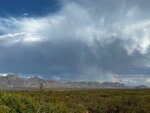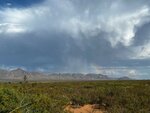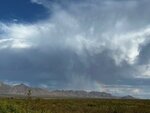




The 2023 monsoon season is “off to a slow start” but likely will have a “gangbuster finish,” said National Weather Service (NWS) meteorologist Jason Laney, based at NWS’ El Paso weather forecast office in Santa Teresa, New Mexico.
The monsoon season started in mid-June, he said, but the onset of the rain it typically brings to southern New Mexico likely will be delayed until early August.
“August and September should be fairly decent months for precipitation,” Laney said.
In the meantime, the area’s record heat will continue, he said.
The monsoon season, officially June 15-Sept. 30, usually brings about five inches of rain to the area, about 60 percent of its total annual precipitation, Laney said.
The region came out of a long-running drought last year because of a wetter-than-normal monsoon season and winter snowpack, he said.
Even so, “The lower Rio Grande is considered abnormally dry,” Laney said. “If things don’t change, we could slip back into moderate drought in the next month.”
This year’s monsoon rains have been delayed because of the late arrival of El Niño, the warm phase of the El Niño–Southern Oscillation (ENSO) weather pattern (winds and sea-surface temperatures) in the equatorial Pacific Ocean that impacts weather around the world. La Niña is the opposite – a cooling phase of ENSO. There is also a third, neutral phase. (“El Niño de Navidad,” a reference to the Christ Child, was given to the warm, south-flowing air current centuries ago by Peruvian fishermen because it was most noticeable around Christmas. “La Niña” [the girl] came into use sometime later to denote the opposite air current.])
A late starting El Niño has meant “heat and dry thunderstorms” in July, Laney said, duplicating the weather pattern more typical in the month of June in southern New Mexico.
This year’s heat wave is already breaking records set in 1994, which Laney described as “a summer without a monsoon.” That year, NWS recorded 62 days that were 100 degrees or hotter, he said, including 23 days in a row.
The NWS had recorded 27 100-or-hotter days in 2023 through July 10, including 26 in row, Laney said.
Those conditions “are likely stay to with us through the end of July,” he said. “We’re on track to be 100 degrees or hotter every day between now and the end of the month.”
What is a monsoon?
A monsoon is not a rainstorm; it’s a seasonal reversal of winds.
In the desert Southwest, prevailing winds are from the west and southwest, Laney said. They come off other desert regions, so they don’t produce a lot of moisture. The pattern shifts in the summer “and we begin to have more of a flow from the south or southeast,” he said. “Most of the time it picks up moisture when it happens.”
Visit www.weather.gov/epz and www.facebook.com/NWSElPaso.